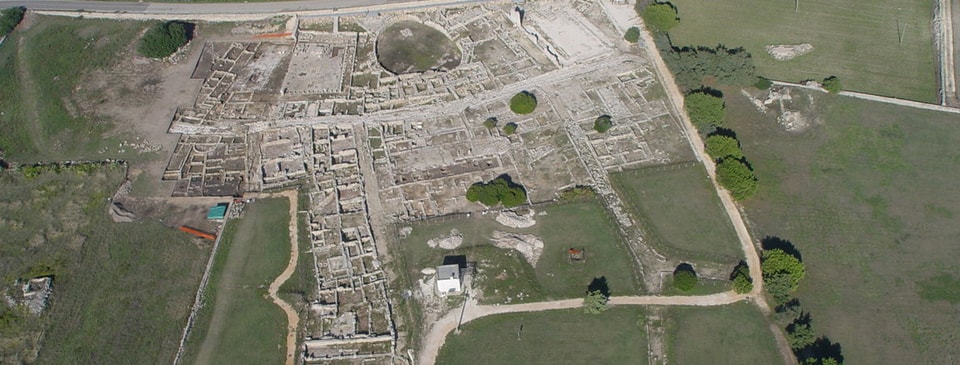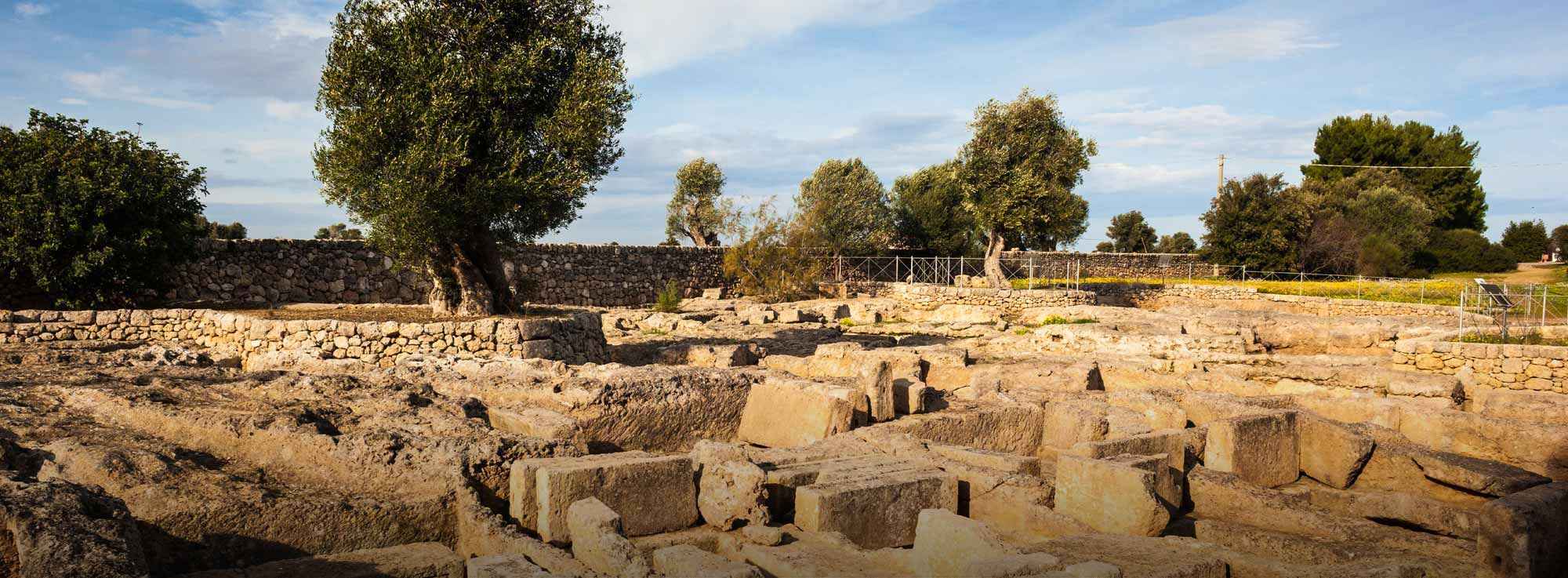



A few kilometers from the trulli of Alberobello and the white city of Ostuni, on the road that connects Bari and Brindisi, the most extensive example of Roman and late ancient cities of Puglia is preserved.
The archaeological site is located near Fasano, between farms and ancient olive trees that overlook a stretch of the Adriatic Sea. It testifies to the history of Egnathia, active commercial center of the ancient world, whose first settlement dates back to the XV century BC (Bronze Age). Inhabited by the Messapians from the eighth century BC, the city first became part of the Republic and then of the Roman Empire until its decline in the Middle Ages.
During the nineteenth century, the remains of Egnathia were sacked by Polish and French officers and subsequently by local agricultural laborers, causing the dispersion of a large number of archaeological finds, mainly coming from the grave goods of the rich Messapian tombs.
Only from 1912 did systematic excavation campaigns take place which, with various continuity solutions, continue today. Currently the area with its 15 hectares of archaeological park and the 1200 square meters of exhibition area of the museum is not simply an area of archaeological excavations and remains, but is now an entire ancient city in the open.
It is in the area of the acropolis that the oldest traces of man's presence in Egnathia were found, dating back to the Middle Bronze Age. Testimony of the continuity of life in later periods are the buildings of worship, including the imposing Trajan sanctuary dedicated to Venus built in the Roman age (2nd century AD).
The remains of the Via Traiana, built between 108 and 110 AD by Emperor Trajan as a variant of the Appian Way to connect Benevento (Beneventum) to Brindisi (Brundisium), they form an ideal division between public buildings and the residential and craft districts of the Roman city.
The Messapian tombs discovered in the necropolis often feature pictorial decorations that provide valuable information relating to the culture and beliefs about the afterlife spread between the fourth and second century BC. In addition to the frescoes, the high standard of living is evident from the presence of numerous chamber tombs - large underground rooms dug out entirely in the rock - and half-chambers, of smaller size. The construction of monumental family tombs testifies to the presence of an emerging aristocratic class.
Among the chamber tombs, great interest was aroused by the discovery of the Pomegranate Tomb, which took place in 1971 during the construction of the museum's foundations. A stairway carved into the rock and a vestibule lead to the underground burial chamber: the extraordinary entrance door, still fully functional today, consists of two monolithic doors equipped with a recessed handle.
The name of the tomb derives from the presence of pomegranates, a symbol of the afterlife, frescoed in the upper part of the walls of the tomb. Lower down there are plant motifs with ivy branches interspersed with palmettes. The ceiling decoration reproduces the typical architectures of Roman houses: the red bands, for example, simulate a double-pitched roof with wooden beams.
The tomb - open to the public only on special occasions through guided tours - is affected by a restoration project that can be financed with Art Bonus, the tax incentive for businesses and individuals who want to support cultural heritage.
Set up in the 1970s in order to collect and exhibit the numerous finds from the excavations of Egnathia to the public, it is divided into chronological sections and documents the history of the settlement from its origins until its decline.
Of particular interest are the specimens of trozzella, a vase typical of the Messapian culture characterized by plastic wheels - called "trozze" - applied on the handles. Next to the precious Apulian red-figure pottery, there are numerous “Gnathia-style” vases, in black paint with overlapping decoration in white and yellow, widespread throughout Puglia.
The amphorae, as well as the great variety of artefacts of Italic, African and Eastern origin, testify to the importance of trade, increased thanks to the construction of the port and the Via Traiana.
The splendid head of Attis with the typical Phrygian cap, belonging to a statue of the Hadrian age carved in fine white marble, is a testimony to the spread of the cult of oriental origin of the Great Mother of the Cybele Gods.
The Museum, named after Giuseppe Andreassi, director of the museum and archaeological area from 1976 to 1985 and Archaeological Superintendent of Puglia from 1990 to 2009, stands outside the walls of ancient Gnathia, in the area of the Messapian necropolis. The city, cited by classical authors for its privileged geographical position, was a strategic commercial port in the connection between the West and the East.The first settlement was built in the 16th century BC. and had life continuity until the Iron Age, when the whole territory of Puglia was inhabited by the Iapigi. Around the end of the 6th century a.C., Egnathia connoted itself as a settlement of Messapia, corresponding to the current provinces of Brindisi and Lecce. Starting from the III sec. BC, with the Roman presence in the area, the city changed and in the first century B.C. it acquired the municipal status, assuming great importance thanks to the presence of the port and the Via Traiana. From the 6th century A.D. the lower part of the inhabited area was gradually abandoned and the allocation continued on the Acropolis, up to the thirteenth century. Of the Messapic phase of Egnazia the mighty defense walls and the necropolis remain, with pit tombs, half-chamber tombs and monumental chamber tombs. Of the Roman city you can admire the remains of the Via Traiana, the Basilica Civile with the classroom of the Three Graces, the Sacello of the oriental gods, the porticoed square, the cryptoporticus and the thermal baths. Among the buildings of Christian worship, built between the fourth and sixth centuries AD, we highlight the Episcopal Basilica with the baptistery and the Southern Basilica, originally paved with mosaics. The museum, built in 1975 outside the walls of the ancient Gnathia, on the edge of the western necropolis, has welcomed since 1981 a series of temporary exhibitions, also permanently maintaining an educational exhibition on 'Egnathia, history and monuments'. The current layout, located on the mezzanine floor where there are also the management and secretarial offices, was inaugurated in July 2013. The exhibition itinerary, divided into 7 sections, tells the story that characterized the archaeological research in Egnathia and the evolution historical site from the sixteenth century B.C. until the thirteenth century AD, the time of abandonment. The finds and images illustrate the peculiarities that characterized the first settlement of huts in the Bronze Age, the influence of the hypiapia and messapic culture, the Roman and early Christian phases, with the city becoming a bishopric. The last section collects evidence relating to the Longobard presence and the last traces of frequentation of the area. The finds come from excavations carried out in the inhabited area and in the necropolis of Egnathia, but also from the territory. In the foundations of the museum there is also a messapic chamber tomb from the 4th century BC, the so-called Pomegranate Tomb.
